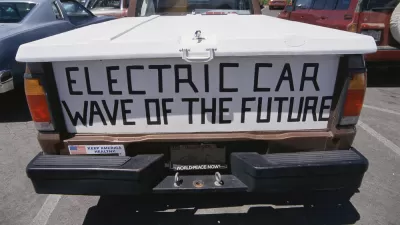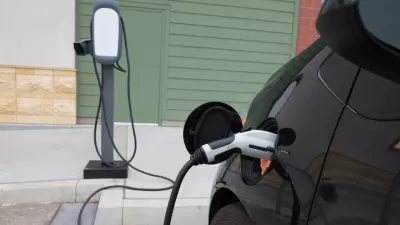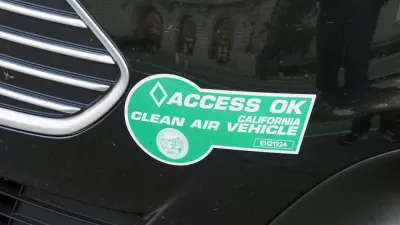Lawmakers want to ensure that electric vehicles are accessible to all Californians, particularly lower-income motorists in disadvantaged communities. Unlike other incentive programs, participants must also scrap an older, polluting vehicle.

New electric vehicles (EVs) tend to be purchased by more affluent consumers, although the price gap is narrowing between electric and internal combustion vehicles as battery prices decrease. Today, used EVs present a good opportunity for lower-income motorists to enjoy the benefits of zero or near-zero-emissions, but most, if not all state rebate programs, as well as the federal EV tax credit, only apply to new vehicles.
Correspondent's note: scroll down to header, "EV rebates and eligible models decrease," to read about important changes to California's EV rebate program that took effect this month.
Legislative background
Due to California's historic air quality problems, the state has a long history with incentive programs to retire older, more polluting vehicles. The passage of Assembly Bill 630 by Assemblyman Jim Cooper (D-Elk Grove) in 2017 established the Clean Cars 4 All program by modifying an existing program that included "scrap and replace," launched by landmark legislation passed in 2007.
The focus of the Clean Cars 4 All program is "reducing greenhouse gas emissions and improving air quality by providing benefits to the state's low-income residents by replacing high-polluting cars with cleaner cars or providing a mobility option," according to the legislative analysis.
Most of the program's funding comes from what the California Air Resources Board's Moving California program, "part of California Climate Investments, a statewide program that puts billions of cap-and-trade [pdf] dollars to work reducing greenhouse gas emissions, strengthening the economy and improving public health and the environment—particularly in disadvantaged communities. At least 35 percent of these investments are made in disadvantaged and low-income communities."
The program is implemented on a regional level by regional air quality management and air pollution control districts in the South Coast, San Joaquin Valley, Sacramento, and the Bay Area.
Bay Area program
"The Clean Cars for All program in the Bay Area started in March and has assisted nearly 200 people who were driving old beaters, including some that date to the 1980s," said Rebecca Fisher with the Bay Area Air Quality Management District that is administering the program, reports
The Sacramento Metropolitan Air Quality Management District held a media launch for its Clean Cars 4 All program on August 7 in Sacramento, with a full launch in early 2020. The local CBS affiliate included a news video in their report on the new program. While the Bay Area program has a Clipper Card mobility option of up to $7,500 good for most of the region's public transit systems, the Sacramento program's transit alternative appears more expansive (see fact sheet [pdf] under "Scrap & Forget") which the TV station took a special interest in, calling it a "cash option."
Since it’s your money helping fund the program, CBS13 asked what happens if you take the cash option. Alberto Ayala, executive director of the Sacramento Metro Air District, said there are boundary conditions on the Visa card. They only work on alternative transportation options like Uber or Lyft or public transit.
If you took the cash option, you can’t use it to go to the store or the movies, but if it’s a qualified transportation option, then the card will be valid.
Electric bike and bikeshare option
As posted in September, with the signing of Senate Bill 400 by State Senator Thomas J. Umberg (D – Orange County), participants will be able to broaden their options next year by purchasing electric bikes and bike-share memberships.
What about new electric vehicles?
Participants are by no means limited to used vehicles. Furthermore, in all likelihood, they qualify for the "increased rebate" of $2,500 for low– and moderate-income consumers (based on federal poverty levels) on top of the standard $2,000 (see below section for recent rebate changes) for battery-electric vehicles. Yes, that amounts up to $14,000 towards a new EV for Clean Cars 4 All participants.
EV rebates and eligible models decrease
As noted earlier, state rebate programs generally are restricted to new vehicles. Dustin Gardiner of the San Francisco Chronicle reported earlier this month about significant changes made by the California Air Resources Board (CARB) to the Clean Vehicle Rebate Project (CVRP), particularly as it applies to the higher-priced EV models and plug-in hybrid electric vehicles (PHEVs).
Effective [Dec. 3], state regulators have stopped offering rebates for buyers of electric cars or plug-in hybrid vehicles that cost more than $60,000 — a move that will make buyers of high-end Tesla models dig deeper into their pockets.
[CARB also] reduced the standard rebate by $500 per vehicle, from $2,500 to $2,000 for all-electric cars, and eliminated rebates for plug-in hybrid cars with an electric-battery range of less than 35 miles.
The second best-selling EV model in the U.S. last year was the Toyota Prius Prime, a PHEV with an electric battery range of 25 miles. The new battery range threshold may cause Prius owners to consider the second best-selling PHEV, the Honda Clarity, which can travel 47 miles on a full charge.
Gardiner's piece is based on an October press release by the Air Resources Board announcing the details of their $533 million funding plan [pdf] for their clean transportation incentive programs.
"The plan serves as a blueprint for expending funds appropriated to CARB in budget bills passed this year by the Legislature and signed by the Governor, including $485 million from cap-and-trade auction proceeds... the remainder – $48 million – is from the Air Quality Improvement Program," according to the release. AQIP is a mobile source incentive program that focuses on reducing criteria pollutant and diesel particulate emissions with concurrent reductions in greenhouse gas emissions created by the aforementioned landmark 2007 legislation, AB 118, that increased vehicle registration and smog abatement fees.
Gardiner reports that the rebates decreases and elimination of high-end value EVs and low-end battery range PHEV result in part from equity as well as budgetary considerations. Rebates for low-income consumers remain unchanged.
Agency officials said the changes will ensure that more people will receive rebates, particularly those with low incomes. Currently, funding for the program runs out every fiscal year, forcing many buyers to join a waiting list that can extend for months.
Melanie Turner, a spokeswoman for the Air Resources Board, said the new rules put an emphasis on rebates for disadvantaged communities, including areas with higher pollution and lower incomes.
Gardiner interviews Assemblyman Phil Ting, the legislature's chief EV advocate who has championed increasing the rebate amounts, though most recently done at the expense of feebates, and Joel Levin, executive director of Plug In America, a non-profit, supporter-driven advocacy group, for their thoughts on the changes to the state's rebate program.
Related in Planetizen:
-
Gov. Jerry Brown Signs 16 Bills to Spur Sales of New and Used Electric Vehicles, September 20, 2018
-
A Dozen New Laws to Spur Sales of Zero Emission Vehicles in California, October 13, 2017
Hat tip to MTC News Headlines and David McCoard.
FULL STORY: With new grant program, Bay Area spreads electric cars to low-income drivers

Study: Maui’s Plan to Convert Vacation Rentals to Long-Term Housing Could Cause Nearly $1 Billion Economic Loss
The plan would reduce visitor accommodation by 25,% resulting in 1,900 jobs lost.

Alabama: Trump Terminates Settlements for Black Communities Harmed By Raw Sewage
Trump deemed the landmark civil rights agreement “illegal DEI and environmental justice policy.”

Why Should We Subsidize Public Transportation?
Many public transit agencies face financial stress due to rising costs, declining fare revenue, and declining subsidies. Transit advocates must provide a strong business case for increasing public transit funding.

Paris Bike Boom Leads to Steep Drop in Air Pollution
The French city’s air quality has improved dramatically in the past 20 years, coinciding with a growth in cycling.

Why Housing Costs More to Build in California Than in Texas
Hard costs like labor and materials combined with ‘soft’ costs such as permitting make building in the San Francisco Bay Area almost three times as costly as in Texas cities.

San Diego County Sees a Rise in Urban Coyotes
San Diego County experiences a rise in urban coyotes, as sightings become prevalent throughout its urban neighbourhoods and surrounding areas.
Urban Design for Planners 1: Software Tools
This six-course series explores essential urban design concepts using open source software and equips planners with the tools they need to participate fully in the urban design process.
Planning for Universal Design
Learn the tools for implementing Universal Design in planning regulations.
Smith Gee Studio
Alamo Area Metropolitan Planning Organization
City of Santa Clarita
Institute for Housing and Urban Development Studies (IHS)
City of Grandview
Harvard GSD Executive Education
Toledo-Lucas County Plan Commissions
Salt Lake City
NYU Wagner Graduate School of Public Service





























